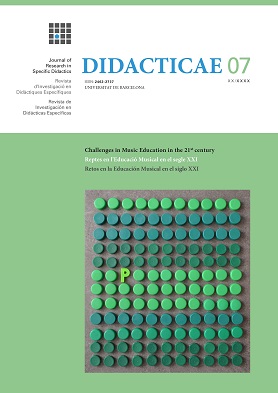La fonética en el aula de Bachillerato. Una propuesta basada en los nuevos modelos de análisis
Phonetics on Secondary Education. A proposal based on new analysis models
DOI:
https://doi.org/10.1344/did.2020.7.136-149Keywords:
phonetics, Spanish language and literature, Spanish as a first language teaching, secondary educationAbstract
After the passing of the latest education law, phonetics has been set aside from the official syllabus of Spanish Language and Literature. Even though in former laws phonetics had barely one section on the teaching programme, that minimum presence allowed one to remember that linguistic studies must not be reduced to only syntactic and morphological exercises, developed frequently in a mechanical way. In this paper, we propose a teaching unit based on concepts related to phonetics with a fresh approach - on the one hand, based on cutting-edge studies about phonetics, and, on the other hand, distant from the deceptively easy and clear traditional approach. The unit developed here offers a clear way to address an introduction to basic phonetics with a thorough linguistic basis, which is an essential part of any study. As a conclusion, we present the results of the tests taken before and after the unit in four courses of baccalaureate. The students showed a positive evolution from the starter test to the end of the unit, when they were assessed with the final test.
References
20minutos (2014). Ruth Lorenzo: “En 2017 vuelvo a Eurovisión” [Vídeo]. Recuperado de https:// youtu.be/IQjvU9ATcxU?t=2m45s
Amate, M. (2016). Cómo cambiar tarifa para pagar 20 euros en la factura luz [Vídeo]. Recuperado de https://youtu.be/ZZ1g16UhWis?t=4m43s
Casado Mancebo, M. (2018). ¿Oclusiva? ¿Fricativa? Un siglo de lucha continua. En E. Álvarez García y M. V. Barrio Corral (Eds.), Estudios panhispánicos: lingüística teórica y aplicada (pp. 13-26). León: Universidad de León.
Dowse, J. (2005). The International Phonetic Alphabet. Recuperado de https://jbdowse.com/old-ipa/
Gil Fernández, J. (1987). Los sonidos del lenguaje. Madrid: Síntesis.
Gil Fernández, J., y Lahoz-Bengoechea, J. M. (en prensa). Fonética y fonología: mapa conceptual. En J. Gil Fernández y J. Llisterri (Eds.), Fonética y fonología descriptivas de la lengua española (Cap. 1). Washington, DC: Georgetown University Press.
Gussenhoven, C., y Jacobs, H. (2013). Understanding phonology. Oxford: Routledge.
Ladefoged, P., y Maddieson, I. (1996). The sounds of the world’s languages (1ª ed.). Oxford: Wiley-Blackwell.
Marrero, V. (2001). Fonética y fonología de la lengua española. Fonética perceptiva (Addenda). Madrid: UNED.
Martínez Celdrán, E. (1991). Fonética experimental: Teoría y práctica. Madrid: Síntesis.
Martínez Celdrán, E. (1993). La percepción categorial de /b-p/ en español basada en las diferencias de duración. Estudios de fonética experimental, (V), 223-239.
Martínez Celdrán, E., y Fernández Planas, A. M. (2013). Manual de fonética española: articulaciones y sonidos de español (2ª ed.). Barcelona: Ariel.
Navarro Tomás, T. (1918). Manual de pronunciación española. Madrid: Centro de Estudios Históricos.
Puntas, T. (2014). Seseo, ceceo y distinción [Vídeo]. Recuperado de https://youtu.be/muewBxZzq4I
Real Decreto 1105/2014, Boletín Oficial del Estado 3 § I (2015).
Russel, D. (s.f.). Longitudinal waves (GIF). Recuperado de http://www.acs.psu.edu/drussell/Demos/waves/wavemotion.html
Speech production and articulation group (2015). The rtMRI IPA chart (John Esling). Recuperado de https://sail.usc.edu/span/rtmri_ipa/je_2015.html
Torreblanca, M. (1979). Un rasgo fonológico de la lengua española. Hispanic Review, 47(1), 455-468.
Downloads
Published
Issue
Section
License
Copyright (c) 2019 Mario Casado Mancebo

This work is licensed under a Creative Commons Attribution-ShareAlike 4.0 International License.
The authors who publish in this journal agree to the following terms:
- Authors retain copyright and grant the journal the right of first publication.
- Submitting a paper does not involve paying any fees.
- Texts will be published under a Creative Commons Attribution Share-Alike 4.0 International License that allows others to share the work, provided they include an acknowledgement of the work’s authorship, its initial publication in this journal and the terms of the license.
- When citing works published in Didacticae, both the autor and the journal must be cited.
- Didacticae does not accept any responsibility for the points of view and statements made by the authors.



